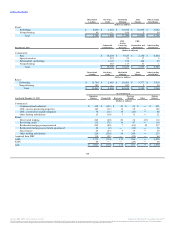BB&T 2014 Annual Report Download - page 103
Download and view the complete annual report
Please find page 103 of the 2014 BB&T annual report below. You can navigate through the pages in the report by either clicking on the pages listed below, or by using the keyword search tool below to find specific information within the annual report.
Table of Contents
Goodwill and Other Intangible Assets
Goodwill represents the cost in excess of the fair value of net assets acquired (including identifiable intangibles) in transactions accounted for as acquisitions.
BB&T allocates goodwill to the reporting unit(s) that receives significant benefits from the acquisition. Goodwill is tested at least annually for impairment
during the fourth quarter of each year and more frequently if circumstances exist that indicate a possible reduction in the fair value of the business below its
carrying value. BB&T measures impairment using the present value of estimated future cash flows based upon available information. Discount rates are based
upon the cost of capital specific to the industry in which the reporting unit operates. If the carrying value of the reporting unit exceeds its fair value, a second
analysis is performed to measure the fair value of all assets and liabilities. If, based on the second analysis, it is determined that the fair value of the assets and
liabilities of the reporting unit is less than the carrying value, BB&T would recognize impairment for the excess of carrying value over fair value.
CDI and other intangible assets include premiums paid for acquisitions of core deposits and other identifiable intangible assets. Intangible assets other than
goodwill, which are determined to have finite lives, are amortized based upon the estimated economic benefits received.
MSRs
BB&T has two primary classes of MSRs for which it separately manages the economic risks: residential and commercial. Residential MSRs are recorded on
the Consolidated Balance Sheets primarily at fair value with changes in fair value recorded as a component of mortgage banking income. Various derivative
instruments are used to mitigate the income statement effect of changes in fair value due to changes in valuation inputs and assumptions of the residential
MSRs. Commercial MSRs are recorded as other assets on the Consolidated Balance Sheets at the lower of cost or market and are amortized in proportion to,
and over the estimated period, that net servicing income is expected to be received based on projections of the amount and timing of estimated future net
cash flows. The amount and timing of estimated future net cash flows are updated based on actual results and updated projections. BB&T periodically
evaluates its commercial MSRs for impairment.
Equity-Based Compensation
BB&T maintains various equity-based compensation plans that provide for the granting of stock options (incentive and nonqualified), stock appreciation
rights, restricted stock, RSUs, performance units and performance shares to selected employees and directors. BB&T values share-based awards at the grant
date fair value and recognizes the expense over the requisite service period taking into account retirement eligibility.
Pension and Postretirement Benefit Obligations
BB&T offers various pension plans and postretirement benefit plans to employees. Calculation of the obligations and related expenses under these plans
requires the use of actuarial valuation methods and assumptions. The discount rate assumption used to measure the postretirement benefit obligations is set
by reference to a high quality corporate bond yield curve and the individual characteristics of the plan such as projected cash flow patterns and payment
durations. The expected long-term rate of return on assets is based on the expected returns for each major asset class in which the plan invests, adjusted for the
weight of each asset class in the target mix.
Insurance Income
Insurance commission revenue is generally recognized at the later of the billing date or the effective date of the related insurance policies. Insurance
premiums from underwriting activities are recognized as income over the policy term. The portion of premiums that will be earned in the future is deferred
and included in other liabilities in the Consolidated Balance Sheets.
Segments
Segment results are presented based on internal management accounting policies that were designed to support BB&T’s strategic objectives. The Other,
Treasury and Corporate segment includes financial data from subsidiaries below the quantitative and qualitative thresholds requiring disclosure. Refer to
Note 21 “Operating Segments”for additional disclosures regarding BB&T’s segments.
102
Source: BB&T CORP, 10-K, February 25, 2015 Powered by Morningstar® Document Research℠
The information contained herein may not be copied, adapted or distributed and is not warranted to be accurate, complete or timely. The user assumes all risks for any damages or losses arising from any use of this information,
except to the extent such damages or losses cannot be limited or excluded by applicable law. Past financial performance is no guarantee of future results.
























